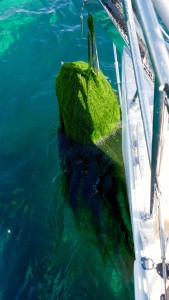

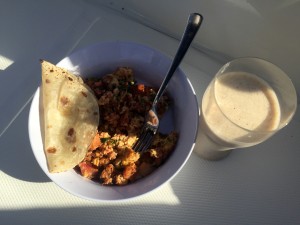
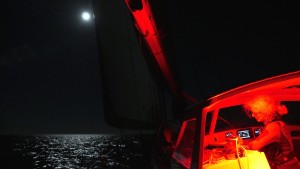




Winter is the slow season in Baja for fishing. Dorado are scarce, we haven’t seen one.
There were rumors of Wahoo back near La Paz. We had a visit from a marlin, but nobody’s fishing for them, mine I caught on the outside. All the charts call for yellowtail, but in Barriles the word was you had to fish deep with mackrel bait, like 200 feet. We heard that again at Punta Chivato, though here the suggestion was to jig with “iron” if you didn’t have bait. We trolled a lot on the way up from La Paz, but the only thing we caught were a couple small either bonita or skipjack, I can’t really say; I know the difference, yet. We don’t keep bonita, after one in Southern CA turned out to be a little… iron rich, shall we say.
Always, birds diving in a frenzy, means big fish have pushed up the bait. We caught two Jack Crevalle in Caleta Partida chasing the birds by casting with a spoon. We were hoping for yellowtail — cuz they’re yummy.
Finally, at Isla Estanque as we were heading out, bound for Bahia de Los Angeles, we got into a bird frenzy that kept going long enough to make a few passes. We picked up a yellowtail on a trolled “Wahoo Bomb” each time we went through. Diana who was at the helm, cheerily pointed out that at three fish we already had plenty to eat… so we were done right? Hard for me to admit, but the birds had calmed down anyway, so it really was time.
Diana made sushi for dinner… inside out rolls, with cucumber, carrot and pasilla chili. Each roll a little better than the last.
That really put us on the hunt for yellowtail. After riding out the cold front/norther (gusts to 39 knots) at Puerto Don Juan, we anchored at the picturesque Esta Ton on the west side of Isla Angel de la Guardia. The promised SW wind had not really materialized in the morning when we left, so we planned to hunt for fish with the fish finder sonar until we got a breeze while trying out the downrigger to troll as deep as we could.
Nothing on the troll, but we found a nice point with at least 2 knots of current swirling passed like a river and marked a waypoint with lots of “targets” from 200 feet to 150 down. It took some maneuvering to get Allora on the right drift, but the first time we really thought we had it right, I dropped and somewhere down there in the briny deep, it felt like it hit and then stuck on the bottom. I pulled hard and it didn’t move. It was a brand new lure (just purchased in Bahia de Los Angeles), and I couldn’t imagine how we’d get it unstuck in this heavy ocean current. Then the fish pulled hard. It fought for a while, putting a nice bend in the pole and then seemed almost to give up. I worried that I lost it, reeling madly until it turned away again and there was no doubt I hadn’t. Still, coming from the depths you never know what you’re in for. Anyway, this was a much bigger yellowtail than the three at Estanque. Again, Diana pointed out that we had a long way to sail, and the wind was coming up and we had plenty for dinner.
Since I have two of those jigs, I’m planning to bend the barb down on one, so I can keep fishing next time. We had one night of sushi and a lunch and dinner of filets from that yummy yellowtail. It’s the perfect fish for a converted trout fisherman, pretty colors and long shape, very trout-like mouth, with no teeth, and not scaly either. Though I did find out the hard way that they have one very sharp barb on their dorsal fin.
Pelicans remind me of the Maribou storks of Africa, only a little more attractive. They do hang with the seagulls a lot, so you have to think of them more as scavengers than fishers. Makes sense to have a big bucket if you’re going to be a garbage man. Seagulls are like the magpies that used to bug us with their racket in Montana, only a lot louder. There must be some reason evolutionary they need to squawk so much. Diana is convinced that they are laughing at us. Anytime we move, they break out in a chorus of gaffaws. It could be that they’re just that emotionally high strung, or like people, that they just have too much to say. Scavengers get a bad name. Not really fair. They have to be alert all the time. They cannot afford to miss a trick.
Purpose doesn’t imply meaning. We must all, ruthlessly, advance our DNA. That’s the DNA talking. Altruism is self-interest of a species, even when you extend it to the environment. We can live in a world without whales (though who would want to), but ultimately not in a world that is busy ridding itself of a treasure trove of beautiful animals.
Puerto Refugio March 11-13, 2016
The sun just rose at the tip of the point that marks one side of the channel to the west bay. We can see it because the breeze which was utterly calm last night has swung around WSW so that we are over our anchor. The range of the spring tide when we dropped the hook was -.9M to 2.5M high, so 3.4 meters. The fishermen who slept on the beach, the gravel beach, got busy at first light (as fishermen do), and already they have left for Bahia de Los Angeles – the small town which only just got electricity a couple years ago, forty miles or so along the arid, uninhabited shore to the south of us.
Yesterday they set up in the cove that is our home these past three or four days at the entrance to a small lagoon, and with long air hoses and a compressor they dove for scallops. They worked hard, all day. It was relatively and they were, as always, completely covered – sweatshirts with hoods, down to white fishing boots. One of the crew of five sported brightly colored plaid pants. The divers here have an arduous and dangerous occupation. Here they were working very shallow, but at Salsipuedes they were diving over 20 meters deep. For hours. Its hard to imagine how they don’t kill themselves. It’s also hard to imagine that there are any rescue teams ready to evacuate them to decompression chambers hundreds of miles away on the mainland, if (when) they do get in trouble.
Diana spoke to them in her virtually nonexistent Spanish (still better than mine), and we waited for them to come buy to sell us some scallops. ‘Ajillo’ (chopped garlic) is what they kept saying, though ‘vieiras’ is the official word, we looked up later. Eventually, we realized that they weren’t taking breaks in their scallop diving, so Diana kayaked over to the beach at sunset when they finally called it a day, prepared to negotiate a good deal for ‘vieiras’ direct from the source (or at least only one step removed, since we have a diving hookah and will get them ourselves once we learn the technique of knifing them off the rocks and figuring out where to look). They had a fire going and were making their dinner when she arrived. She was able to get an idea from them what the market price would be (kinda what she guessed) but they wouldn’t sell them to her. Nope. They insisted on giving them to her free, a huge bag of them (at least 50 giant scallops). So much for her negotiating skills. And, when she somehow managed to communicate that her husband (she probably tried the Italian word “merito” or “espouse”) liked chili peppers, like the ones they were frying with their fish for dinner, they gave her a ‘to go’ plate of fried fish and peppers. At the grey whale camp in San Ignacio they would have called it sea bass. She managed to make them take a few pesos and she had already given them a bag of rice crackers. She came back to the boat with the yummy fish and peppers (which went nicely with the end of my beer) and then decided that the generosity was decidedly too one-sided. She cut up a loaf of banana bread she’d baked that afternoon and brought it over to the boys, like a nice Mexican mama, hoping that something different from what they must eat every day, would be a treat. This time she got a picture. They lined up for their portrait when she pulled out the iphone.
Who knows what the rest of our journey will hold, but right now we aren’t far at all (as the crow or jet flies) from the big, sophisticated cities of California and the US where no one would ever consider giving away a five pound bag of beautiful scallops they’d just worked like coal miners to get. Especially not to some apparently wealthy foreigners in a brand new yacht anchored in their spot who was asking to buy them. They had a different idea altogether from their not so distant neighbors on the other side of Donald Trump’s would-be spectacular Great Wall. They have fished here, no doubt for generations. Living as hard and simple a life as you would expect to find. They keep a small shrine on top of the rock, painted, gaudy, fire-engine red, and used some of the left over paint to write their names on the dark rocks. They seemed pretty content in this place where even I can go catch a few one-taco cabrilla on demand. Fried with a some spicy peppers and a little sip of Tequilla. Not too shabby. 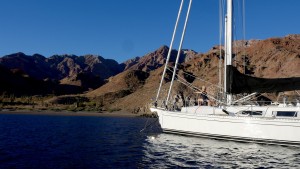
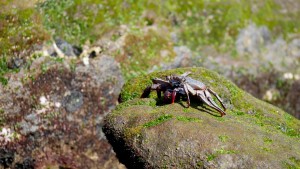
Waking up on the boat, at anchor, you never know what side the sunrise will arrive from. Until you go up on deck your whole world can be oriented an entirely different direction. Closer to these rocks, further from that shore, sun at the bow or stern. The beach long and wet, or completely gone with the tide. No sense building Stonehenge on a boat. It’s a pleasant thing to be surprised each morning, to take a moment, coffee in hand and visually adjust to the temporary new reality of your setting. Sailing is about constant change.
Sunrise at Isla el Pescador (Isla Rocallosa)
Last night a light flickered on and off at one of the beach palapas. Otherwise it was still enough that the Milky Way was reflected in the water. Stars and planets shimmered on both spheres. This morning with the sunrise a small group of dolphins (the bigger kind, Bottlenose), porpoised quietly around the boat.
Yesterday we made a grocery run to Bahia de Los Angeles. Anchor, get Namo in the water, lug the groceries (including milk, drinks and beer) back. There are several places to hunt vegetables in this ramshackle little town. Saturday is the best foraging, Wednesday not so much. The biggest and closest sets off a road with broken edges and dusty shoulders up from the main boat launch. There, we were serenaded by a very drunk man sitting beside the checkout counter, snatches of what must be famous Mexican ballads. At least in his mind. It was two in the afternoon, so we had to admire his fortitude, if not necessarily his pitch. With a nod from the woman checking us out using a pocket calculator, we were granted a ride. Bags in the back of the old pickup along side sundry items including used kids paint containers and the battered remains of a pinàta.
Up anchor and a brisk sail out of the bay, to find the oddest wind and uncomfortable chop in Canal de Ballenas. The instruments at the top of the mast dutifully reported 12 knots aft of the beam, but on deck it was maybe 4 and dead aft. Add a little rolling in the chop and the genoa had no idea what to do with herself. We rolled it up and wind promptly jumped to 17 knots and actually felt like it. We were just contemplating unfurling when the certified cetacean addict on board belted out an emphatic “Thar she blows!” pointing between us and the “dangerous submerged rocks” along shore to starboard, by Punta Don Juan. A good Captain knows his crew, and doesn’t have to be told what they expect. Hard to starboard, damn the rocks. A whale! For anyone following our track closely, these odd detours rarely mean we are lost, generally they are motivated by whales, dolphins or birds diving over fish (and we power off course with yellowtail, sushi on our minds). This particular whale, a small humpback (we think), was doing some mighty tail slapping (‘lobtailing’) and it was dramatic. We were able to get pretty close and enjoy the show for a while, before the cetacean-lover who can never get enough, conceded that she also did not want to drop anchor in the dark.
This pretty little cove is the only place you can anchor along the west coast of the island. Otherwise it is an impressive mountain ridge that reminds us of mountains in drier parts of Nevada. A vein of red up on the peak just north of us stands out in the nearly bare rock and down at the water level, darker stone is streaked with veins of white. The hook of shore that embraces us to the east is crowned with a classic, cardon cactus. It stands like a familiar marker of a blue ribbon anchorage, like the lone cactus at the saddle around from Dog Bay on Isla Tiburon. We’ve left the mountains, but here at least we have familiar landscapes at the edge of the sea.
The results about Diana’s Uncle Tom, came yesterday. The tumor in his brain, stage four, aggressive. This evil thing developed quickly, and they can only guarantee that they were not able to get all of it. This has been a hard test for Diana, who dearly loves her uncle, unabashedly claiming status as the favorite niece (he makes each one feel they have the title). If she were in Montana, she would have booked a flight, been there when Camille and her Uncle Joe came to see their little brother. To get there from here we would have to sail backward, downwind to Santa Rosalia where the boat could be kept safely. Rent a car, drive to Loreto. It’s doable, but it’s a big lift. We’ve just begun. We will turn back in a few weeks. The fact is that there is time, that right now the doctors need to do their thing, the long shot trial treatment he only qualified for because his tumor is the worst kind.
All this comes as we find ourselves further and further away from the usual communication infrastructure. We connect now only by satellite and it’s pretty good, better than it would have been just a couple years ago, but as days go by and we’ve seen only two other boats, and a handful of panga fishermen, we are very aware of how remote this beautiful part of the world is. My computer crashed, so this iPad is our only link, and Diana is feeling the distance from family and friends that weighs against her passion for this adventure. We feel our friends going on with lives that are very different than whatever this will be. There is something oddly unsettling about the idea that a trip has been planned to Bali. It will takes us four years, at least, to get there as we wait out the seasons and visit the places in between. It’s not just that sailing is slow, our top speed is about twelve miles an hour, eight is more typical, but we are at the mercy of the wind in the most absolute sense. So if it’s going to blow hard for a week to the point that beating against the seas would be pointless or even dangerous, we have no choice but to hide out until it stops. We have to make sure when we move that we know where we’re going to hide when the next norther sets in, or the next cold front makes a surprise visit. A place where our anchor can hold us. It’s the waves that are the enemy, not really the wind. Though the 39 knots gusts that accompanied the last front shook Allora and tipped her over and strained her anchor bridle, our little hurricane hole (Puerto Don Juan) was pretty impervious to the big rollers we could see smashing out at the point, and it wasn’t too bad. We just can’t afford to get it wrong and get caught on the wrong side of an island. This will be the same thing on a much bigger scale as we make our way from Mexico to Central America, passed the infamous Gulf of Tehuantepec where gail warnings with 40 knot winds and huge seas are more common than the rare two day weather windows. Then there is the big blow that drives our schedule as well; hurricane season starts in June or July and doesn’t quit til November, when it picks up in the southern hemisphere.
We sailed to this little cove from Puerto Don Juan. Flat water, and a quick port tack, the wind freshened to 20 knots just as we arrived on a beam reach. The hydrogenerator was cooking, putting out thirty amps plus twenty from the solar panels. Power has not been a problem here in sunny Baja. In fact, I put away our extra solar panel because it was unnecessary. We haven’t been plugged in since we left La Paz back in January, and still our batteries are regularly topped off. Between solar that just gets better with spring coming, the hydrogenerator and two alternators on engines when we occasionally have to motor, or power in and out of anchorages, or detour to do a little fishing or whale watching, we’re set. Our biggest power eater is making water, which costs us about 37Ah for thirteen gallons of fresh water. We decided not to top off in Santa Rosalia because their water was so hard. We took a little and diluted it with our own. We’re careful with water, mainly because we don’t like the noise of the watermaker running. No doubt, compared to some of our fellow sailors here in Baja (a few don’t carry watermakers and have to haul it onboard), we are pretty fresh water rich. It’s pretty cool, using sunshine and motion to provide ourselves with showers and drinking water.
We’ve seen just two other boats up in the Northern Sea. One was a fancy trawler named Salispuedes, after the anchorage where she was moored. The owners, retired farmers from Great Falls, took me fishing in their very tricked out fishing skiff, and taught me a few things that have significantly improved my fish catching. The second was a sailboat singlehanded by a gentleman (kackies, belt and long sleeved polo shirt) from Vancouver island, who shared Puero Don Juan for the big blow.